
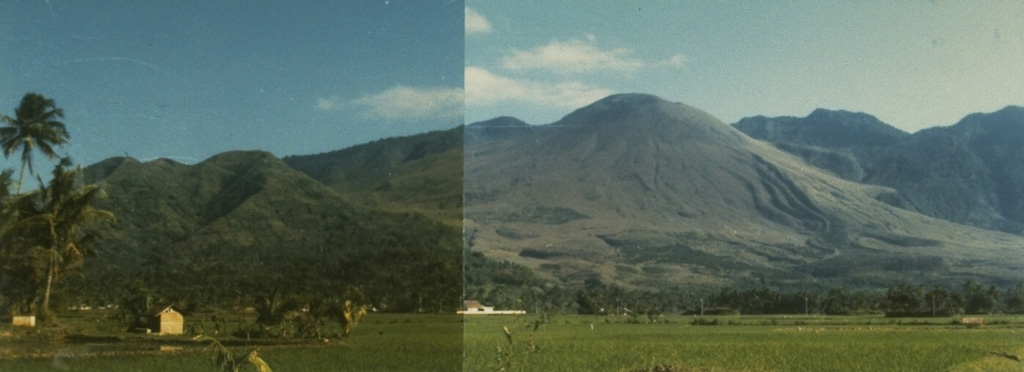
CVGHM reported that the number of deep and shallow volcanic earthquakes at Guntur increased during 15-21 August; seismicity declined after that period. On 30 August at 0820 seismicity again increased, characterized by continuous tremor that lasted until 1450. At 1600 CVGHM raised the Alert Level to 2 (on a scale of 1-4) and reminded residents and visitors not to approach the active crater within a 2-km radius.
Source: Pusat Vulkanologi dan Mitigasi Bencana Geologi (PVMBG, also known as CVGHM)
Increased seismicity since December 2002
During December 2002, the Volcanological Survey of Indonesia (VSI) reported that activity at Guntur was higher than normal. As a result, the Alert Level was raised to 2 (on a scale of 1-4). No plume was observed, but deep and shallow volcanic earthquakes were registered, as well as tectonic earthquakes, through at least mid-May 2003. Tremor was also reported occasionally (table 1). On 28 December a "white ash plume around Guntur crater and Kabuyutan crater reached 3 m high." No ashfall was reported. The temperature at Guntur crater was 79.7°C and at Kabuyutan was 92.7°C. EDM deformation measurements taken on 22 November, 14 December, and 28 December 2002 revealed 11 cm of inflation. On 13 January 2003, an earthquake (MM 2-3) was felt in surrounding areas. Elevated tremor was noted during the first week of April 2003. Guntur remained at Alert Level 2 throughout mid-May.
Table 1. Seismicity at Guntur during 1 December 2002-18 May 2003. Courtesy of VSI.
| Date | Deep volcanic (A-type) | Shallow volcanic (B-type) | Tectonic |
| 01 Dec-08 Dec 2002 | 8 | 8 | 19 |
| 09 Dec-15 Dec 2002 | 5 | 12 | 23 |
| 16 Dec-22 Dec 2002 | 2 | 6 | 16 |
| 23 Dec-29 Dec 2002 | -- | 5 | 14 |
| 30 Dec-05 Jan 2003 | 8 | 24 | 15 |
| 06 Jan-12 Jan 2003 | 3 | 6 | 12 |
| 13 Jan-19 Jan 2003 | 2 | 11 | 12 |
| 20 Jan-26 Jan 2003 | 3 | 23 | 20 |
| 27 Jan-02 Feb 2003 | 5 | 5 | 22 |
| 03 Feb-09 Feb 2003 | 5 | 4 | 11 |
| 10 Feb-16 Feb 2003 | 4 | 5 | 22 |
| 17 Feb-23 Feb 2003 | 3 | 11 | 17 |
| 24 Feb-02 Mar 2003 | 6 | 4 | 19 |
| 03 Mar-09 Mar 2003 | 3 | 10 | 30 |
| 10 Mar-16 Mar 2003 | 4 | 5 | 20 |
| 17 Mar-23 Mar 2003 | 1 | 3 | 28 |
| 24 Mar-30 Mar 2003 | 4 | 4 | 24 |
| 31 Mar-06 Apr 2003 | 13 | 6 | 23 |
| 07 Apr-13 Apr 2003 | 5 | 2 | 17 |
| 14 Apr-20 Apr 2003 | 3 | 3 | 22 |
| 21 Apr-27 Apr 2003 | 6 | 3 | 31 |
| 28 Apr-04 May 2003 | 4 | 2 | 18 |
| 05 May-11 May 2003 | 2 | -- | 24 |
| 12 May-18 May 2003 | 3 | 1 | 19 |
Information Contacts: Dali Ahmad, Volcanological Survey of Indonesia (VSI), Jalan Diponegoro No. 57, Bandung 40122, Indonesia (URL: http://www.vsi.esdm.go.id/).
2013: May
| August
2002: December
CVGHM reported that the number of deep and shallow volcanic earthquakes at Guntur increased during 15-21 August; seismicity declined after that period. On 30 August at 0820 seismicity again increased, characterized by continuous tremor that lasted until 1450. At 1600 CVGHM raised the Alert Level to 2 (on a scale of 1-4) and reminded residents and visitors not to approach the active crater within a 2-km radius.
Source: Pusat Vulkanologi dan Mitigasi Bencana Geologi (PVMBG, also known as CVGHM)
CVGHM reported that in early March a slight increase of deep and shallow volcanic-tectonic earthquakes at Guntur was recorded; volcanic tremor became continuous on 2 April, prompting CVGHM to raise the Alert Level to 2 (on a scale of 1-4).
Temperature measurements of hot springs in five different areas fluctuated until mid-April and then were relatively stable through early May. Seismicity also decreased in early May. On 7 May the Alert Level was lowered to 1.
Source: Pusat Vulkanologi dan Mitigasi Bencana Geologi (PVMBG, also known as CVGHM)
During 9-15 December higher-than-normal seismicity at Guntur led VSI to raise the Alert Level to 2 (on a scale of 1-4). Visual observations of the summit did not reveal any surface changes or ash plumes. In comparison to the previous week, the number of shallow volcanic and tectonic earthquakes increased, while deep volcanic earthquakes decreased. Seismicity remained higher than normal during 16-22 December, but fewer earthquakes occurred than during the previous week. The Alert Level remained at 2.
Source: Pusat Vulkanologi dan Mitigasi Bencana Geologi (PVMBG, also known as CVGHM)
Reports are organized chronologically and indexed below by Month/Year (Publication Volume:Number), and include a one-line summary. Click on the index link or scroll down to read the reports.
Increased seismicity since December 2002
During December 2002, the Volcanological Survey of Indonesia (VSI) reported that activity at Guntur was higher than normal. As a result, the Alert Level was raised to 2 (on a scale of 1-4). No plume was observed, but deep and shallow volcanic earthquakes were registered, as well as tectonic earthquakes, through at least mid-May 2003. Tremor was also reported occasionally (table 1). On 28 December a "white ash plume around Guntur crater and Kabuyutan crater reached 3 m high." No ashfall was reported. The temperature at Guntur crater was 79.7°C and at Kabuyutan was 92.7°C. EDM deformation measurements taken on 22 November, 14 December, and 28 December 2002 revealed 11 cm of inflation. On 13 January 2003, an earthquake (MM 2-3) was felt in surrounding areas. Elevated tremor was noted during the first week of April 2003. Guntur remained at Alert Level 2 throughout mid-May.
Table 1. Seismicity at Guntur during 1 December 2002-18 May 2003. Courtesy of VSI.
| Date | Deep volcanic (A-type) | Shallow volcanic (B-type) | Tectonic |
| 01 Dec-08 Dec 2002 | 8 | 8 | 19 |
| 09 Dec-15 Dec 2002 | 5 | 12 | 23 |
| 16 Dec-22 Dec 2002 | 2 | 6 | 16 |
| 23 Dec-29 Dec 2002 | -- | 5 | 14 |
| 30 Dec-05 Jan 2003 | 8 | 24 | 15 |
| 06 Jan-12 Jan 2003 | 3 | 6 | 12 |
| 13 Jan-19 Jan 2003 | 2 | 11 | 12 |
| 20 Jan-26 Jan 2003 | 3 | 23 | 20 |
| 27 Jan-02 Feb 2003 | 5 | 5 | 22 |
| 03 Feb-09 Feb 2003 | 5 | 4 | 11 |
| 10 Feb-16 Feb 2003 | 4 | 5 | 22 |
| 17 Feb-23 Feb 2003 | 3 | 11 | 17 |
| 24 Feb-02 Mar 2003 | 6 | 4 | 19 |
| 03 Mar-09 Mar 2003 | 3 | 10 | 30 |
| 10 Mar-16 Mar 2003 | 4 | 5 | 20 |
| 17 Mar-23 Mar 2003 | 1 | 3 | 28 |
| 24 Mar-30 Mar 2003 | 4 | 4 | 24 |
| 31 Mar-06 Apr 2003 | 13 | 6 | 23 |
| 07 Apr-13 Apr 2003 | 5 | 2 | 17 |
| 14 Apr-20 Apr 2003 | 3 | 3 | 22 |
| 21 Apr-27 Apr 2003 | 6 | 3 | 31 |
| 28 Apr-04 May 2003 | 4 | 2 | 18 |
| 05 May-11 May 2003 | 2 | -- | 24 |
| 12 May-18 May 2003 | 3 | 1 | 19 |
Information Contacts: Dali Ahmad, Volcanological Survey of Indonesia (VSI), Jalan Diponegoro No. 57, Bandung 40122, Indonesia (URL: http://www.vsi.esdm.go.id/).
|
|
||||||||||||||||||||||||||
There is data available for 24 confirmed eruptive periods.
[ 1887 ] Uncertain Eruption
| Episode 1 | Eruption (Explosive / Effusive) | ||||
|---|---|---|---|---|
| 1887 - Unknown | Evidence from Unknown | |||
[ 1885 Jan 18 ] Uncertain Eruption
| Episode 1 | Eruption (Explosive / Effusive) | ||||
|---|---|---|---|---|
| 1885 Jan 18 - Unknown | Evidence from Unknown | |||
[ 1849 ] Discredited Eruption
An eruption in 1849 not in other sources was listed by de Neve (1985); Sapper (1927) listed this as increased activity, not an eruption.
1847 Oct 16 - 1847 Oct 28 Confirmed Eruption (Explosive / Effusive) VEI: 2
| Episode 1 | Eruption (Explosive / Effusive) | ||||||||||||||||||||||||
|---|---|---|---|---|---|---|---|---|---|---|---|---|---|---|---|---|---|---|---|---|---|---|---|---|
| 1847 Oct 16 - 1847 Oct 28 | Evidence from Observations: Reported | |||||||||||||||||||||||
|
List of 3 Events for Episode 1
|
||||||||||||||||||||||||
1843 Nov 26 - 1843 Nov 26 Confirmed Eruption (Explosive / Effusive) VEI: 2 (?)
| Episode 1 | Eruption (Explosive / Effusive) | |||||||||||||||||||||||||||||
|---|---|---|---|---|---|---|---|---|---|---|---|---|---|---|---|---|---|---|---|---|---|---|---|---|---|---|---|---|---|
| 1843 Nov 26 - 1843 Nov 26 | Evidence from Observations: Reported | ||||||||||||||||||||||||||||
|
List of 4 Events for Episode 1
|
|||||||||||||||||||||||||||||
1843 Jan 4 - 1843 Jan 4 Confirmed Eruption (Explosive / Effusive) VEI: 3
| Episode 1 | Eruption (Explosive / Effusive) | ||||||||||||||||||||||||
|---|---|---|---|---|---|---|---|---|---|---|---|---|---|---|---|---|---|---|---|---|---|---|---|---|
| 1843 Jan 4 - 1843 Jan 4 | Evidence from Observations: Reported | |||||||||||||||||||||||
|
List of 3 Events for Episode 1
|
||||||||||||||||||||||||
1841 Nov 14 - 1841 Nov 14 Confirmed Eruption (Explosive / Effusive) VEI: 2
| Episode 1 | Eruption (Explosive / Effusive) | ||||||||||||||||||||||||||||||||||
|---|---|---|---|---|---|---|---|---|---|---|---|---|---|---|---|---|---|---|---|---|---|---|---|---|---|---|---|---|---|---|---|---|---|---|
| 1841 Nov 14 - 1841 Nov 14 | Evidence from Observations: Reported | |||||||||||||||||||||||||||||||||
|
List of 5 Events for Episode 1
|
||||||||||||||||||||||||||||||||||
1840 May 20 - 1840 May 24 Confirmed Eruption (Explosive / Effusive) VEI: 2
| Episode 1 | Eruption (Explosive / Effusive) | |||||||||||||||||||||||||||||||||||||||
|---|---|---|---|---|---|---|---|---|---|---|---|---|---|---|---|---|---|---|---|---|---|---|---|---|---|---|---|---|---|---|---|---|---|---|---|---|---|---|---|
| 1840 May 20 - 1840 May 24 | Evidence from Observations: Reported | ||||||||||||||||||||||||||||||||||||||
|
List of 6 Events for Episode 1
|
|||||||||||||||||||||||||||||||||||||||
1836 Oct 11 Confirmed Eruption (Explosive / Effusive) VEI: 2
| Episode 1 | Eruption (Explosive / Effusive) | |||||||||||||||||||
|---|---|---|---|---|---|---|---|---|---|---|---|---|---|---|---|---|---|---|---|
| 1836 Oct 11 - Unknown | Evidence from Observations: Reported | ||||||||||||||||||
|
List of 2 Events for Episode 1
|
|||||||||||||||||||
1834 Dec - 1835 Jan Confirmed Eruption (Explosive / Effusive) VEI: 2
| Episode 1 | Eruption (Explosive / Effusive) | ||||||||||||||||||||||||||||||||||
|---|---|---|---|---|---|---|---|---|---|---|---|---|---|---|---|---|---|---|---|---|---|---|---|---|---|---|---|---|---|---|---|---|---|---|
| 1834 Dec - 1835 Jan | Evidence from Observations: Reported | |||||||||||||||||||||||||||||||||
|
List of 5 Events for Episode 1
|
||||||||||||||||||||||||||||||||||
1833 Sep 1 Confirmed Eruption (Explosive / Effusive) VEI: 2
| Episode 1 | Eruption (Explosive / Effusive) | |||||||||||||||||||
|---|---|---|---|---|---|---|---|---|---|---|---|---|---|---|---|---|---|---|---|
| 1833 Sep 1 - Unknown | Evidence from Observations: Reported | ||||||||||||||||||
|
List of 2 Events for Episode 1
|
|||||||||||||||||||
1832 Aug 8 - 1832 Aug 13 Confirmed Eruption (Explosive / Effusive) VEI: 2
| Episode 1 | Eruption (Explosive / Effusive) | |||||||||||||||||||
|---|---|---|---|---|---|---|---|---|---|---|---|---|---|---|---|---|---|---|---|
| 1832 Aug 8 - 1832 Aug 13 | Evidence from Observations: Reported | ||||||||||||||||||
|
List of 2 Events for Episode 1
|
|||||||||||||||||||
1832 Jan 16 Confirmed Eruption (Explosive / Effusive) VEI: 2
| Episode 1 | Eruption (Explosive / Effusive) | |||||||||||||||||||
|---|---|---|---|---|---|---|---|---|---|---|---|---|---|---|---|---|---|---|---|
| 1832 Jan 16 - Unknown | Evidence from Observations: Reported | ||||||||||||||||||
|
List of 2 Events for Episode 1
|
|||||||||||||||||||
1829 Confirmed Eruption (Explosive / Effusive) VEI: 2
| Episode 1 | Eruption (Explosive / Effusive) | |||||||||||||||||||||||||||||
|---|---|---|---|---|---|---|---|---|---|---|---|---|---|---|---|---|---|---|---|---|---|---|---|---|---|---|---|---|---|
| 1829 - Unknown | Evidence from Observations: Reported | ||||||||||||||||||||||||||||
|
List of 4 Events for Episode 1
|
|||||||||||||||||||||||||||||
1828 May 14 - 1828 Jul 8 Confirmed Eruption (Explosive / Effusive) VEI: 2
| Episode 1 | Eruption (Explosive / Effusive) | |||||||||||||||||||
|---|---|---|---|---|---|---|---|---|---|---|---|---|---|---|---|---|---|---|---|
| 1828 May 14 - 1828 Jul 8 | Evidence from Observations: Reported | ||||||||||||||||||
|
List of 2 Events for Episode 1
|
|||||||||||||||||||
1827 May 13 Confirmed Eruption (Explosive / Effusive) VEI: 2
| Episode 1 | Eruption (Explosive / Effusive) | ||||||||||||||||||||||||
|---|---|---|---|---|---|---|---|---|---|---|---|---|---|---|---|---|---|---|---|---|---|---|---|---|
| 1827 May 13 - Unknown | Evidence from Observations: Reported | |||||||||||||||||||||||
|
List of 3 Events for Episode 1
|
||||||||||||||||||||||||
1825 Jun 14 - 1825 Jun 15 Confirmed Eruption (Explosive / Effusive) VEI: 2
| Episode 1 | Eruption (Explosive / Effusive) | ||||||||||||||||||||||||||||||||||
|---|---|---|---|---|---|---|---|---|---|---|---|---|---|---|---|---|---|---|---|---|---|---|---|---|---|---|---|---|---|---|---|---|---|---|
| 1825 Jun 14 - 1825 Jun 15 | Evidence from Observations: Reported | |||||||||||||||||||||||||||||||||
|
List of 5 Events for Episode 1
|
||||||||||||||||||||||||||||||||||
1818 Oct 21 - 1818 Oct 24 Confirmed Eruption (Explosive / Effusive) VEI: 2
| Episode 1 | Eruption (Explosive / Effusive) | |||||||||||||||||||||||||||||||||||||||
|---|---|---|---|---|---|---|---|---|---|---|---|---|---|---|---|---|---|---|---|---|---|---|---|---|---|---|---|---|---|---|---|---|---|---|---|---|---|---|---|
| 1818 Oct 21 - 1818 Oct 24 | Evidence from Observations: Reported | ||||||||||||||||||||||||||||||||||||||
|
List of 6 Events for Episode 1
|
|||||||||||||||||||||||||||||||||||||||
1816 Sep 21 Confirmed Eruption (Explosive / Effusive) VEI: 2
| Episode 1 | Eruption (Explosive / Effusive) | |||||||||||||||||||
|---|---|---|---|---|---|---|---|---|---|---|---|---|---|---|---|---|---|---|---|
| 1816 Sep 21 - Unknown | Evidence from Observations: Reported | ||||||||||||||||||
|
List of 2 Events for Episode 1
|
|||||||||||||||||||
1815 Aug 15 Confirmed Eruption (Explosive / Effusive) VEI: 2
| Episode 1 | Eruption (Explosive / Effusive) | |||||||||||||||||||
|---|---|---|---|---|---|---|---|---|---|---|---|---|---|---|---|---|---|---|---|
| 1815 Aug 15 - Unknown | Evidence from Observations: Reported | ||||||||||||||||||
|
List of 2 Events for Episode 1
|
|||||||||||||||||||
1809 May 9 Confirmed Eruption (Explosive / Effusive) VEI: 2
| Episode 1 | Eruption (Explosive / Effusive) | |||||||||||||||||||
|---|---|---|---|---|---|---|---|---|---|---|---|---|---|---|---|---|---|---|---|
| 1809 May 9 - Unknown | Evidence from Observations: Reported | ||||||||||||||||||
|
List of 2 Events for Episode 1
|
|||||||||||||||||||
1807 Sep 1 - 1807 Sep 6 Confirmed Eruption (Explosive / Effusive) VEI: 2
| Episode 1 | Eruption (Explosive / Effusive) | |||||||||||||||||||
|---|---|---|---|---|---|---|---|---|---|---|---|---|---|---|---|---|---|---|---|
| 1807 Sep 1 - 1807 Sep 6 | Evidence from Observations: Reported | ||||||||||||||||||
|
List of 2 Events for Episode 1
|
|||||||||||||||||||
1803 Apr 3 - 1803 Apr 15 Confirmed Eruption (Explosive / Effusive) VEI: 2
| Episode 1 | Eruption (Explosive / Effusive) | |||||||||||||||||||
|---|---|---|---|---|---|---|---|---|---|---|---|---|---|---|---|---|---|---|---|
| 1803 Apr 3 - 1803 Apr 15 | Evidence from Observations: Reported | ||||||||||||||||||
|
List of 2 Events for Episode 1
|
|||||||||||||||||||
1800 Confirmed Eruption (Explosive / Effusive)
| Episode 1 | Eruption (Explosive / Effusive) | ||||||||||||||||||||||||
|---|---|---|---|---|---|---|---|---|---|---|---|---|---|---|---|---|---|---|---|---|---|---|---|---|
| 1800 - Unknown | Evidence from Observations: Reported | |||||||||||||||||||||||
|
List of 3 Events for Episode 1
|
||||||||||||||||||||||||
1780 Confirmed Eruption (Explosive / Effusive) VEI: 2
| Episode 1 | Eruption (Explosive / Effusive) | ||||||||||||||||||||||||
|---|---|---|---|---|---|---|---|---|---|---|---|---|---|---|---|---|---|---|---|---|---|---|---|---|
| 1780 - Unknown | Evidence from Observations: Reported | |||||||||||||||||||||||
|
List of 3 Events for Episode 1
|
||||||||||||||||||||||||
1777 Confirmed Eruption (Explosive / Effusive) VEI: 2 (?)
| Episode 1 | Eruption (Explosive / Effusive) | ||||||||||||||
|---|---|---|---|---|---|---|---|---|---|---|---|---|---|---|
| 1777 - Unknown | Evidence from Observations: Reported | |||||||||||||
|
List of 1 Events for Episode 1
|
||||||||||||||
1690 Confirmed Eruption (Explosive / Effusive) VEI: 3
| Episode 1 | Eruption (Explosive / Effusive) | |||||||||||||||||||||||||||||
|---|---|---|---|---|---|---|---|---|---|---|---|---|---|---|---|---|---|---|---|---|---|---|---|---|---|---|---|---|---|
| 1690 - Unknown | Evidence from Observations: Reported | ||||||||||||||||||||||||||||
|
List of 4 Events for Episode 1
|
|||||||||||||||||||||||||||||
This compilation of synonyms and subsidiary features may not be comprehensive. Features are organized into four major categories: Cones, Craters, Domes, and Thermal Features. Synonyms of features appear indented below the primary name. In some cases additional feature type, elevation, or location details are provided.
Synonyms |
||||
| Goentoer | ||||
Cones |
||||
| Feature Name | Feature Type | Elevation | Latitude | Longitude |
| Agung | Cone - Crater | 2150 m | 7° 8' 39.00" S | 107° 50' 25.00" E |
| Guntur, Gunung | Cone - Crater | 1960 m | 7° 9' 13.00" S | 107° 51' 1.00" E |
| Masigit | Stratovolcano | 2182 m | 7° 8' 13.00" S | 107° 51' 14.00" E |
| Picung
Pitjung |
Stratovolcano | 1999 m | 7° 8' 26.00" S | 107° 52' 3.00" E |
| Putri, Gunung | Cone | 1400 m | ||
Craters |
||||
| Feature Name | Feature Type | Elevation | Latitude | Longitude |
| Ayakan
Ajakan |
Crater | |||
| Cipanas | Crater | 1797 m | 7° 9' 19.00" S | 107° 51' 6.00" E |
| Gajah
Gadjah |
Crater | 2040 m | ||
| Geulis | Crater | 2191 m | ||
| Japati
Djapati |
Crater | 2030 m | ||
| Kabuyutan
Kabujutan |
Crater | 2048 m | ||
| Parupuyan
Parupujan |
Crater | 2135 m | ||
| Sangiang Buruan | Crater | 2062 m | ||
| Sangiang Jarian
Sangiang Djarian |
Crater | 1680 m | ||
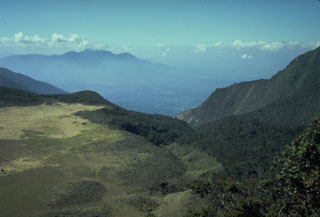 The flat area to the left is Alun-Alun, the uppermost of four large craters on Papandayan volcano. The v-shaped valley in the center of the photo extending to the NE is the breach left by collapse of Papandayan volcano in 1772. The volcano in the distance on the left horizon is Gunung Guntur, another historically active volcano bordering the Garut Plain.
The flat area to the left is Alun-Alun, the uppermost of four large craters on Papandayan volcano. The v-shaped valley in the center of the photo extending to the NE is the breach left by collapse of Papandayan volcano in 1772. The volcano in the distance on the left horizon is Gunung Guntur, another historically active volcano bordering the Garut Plain.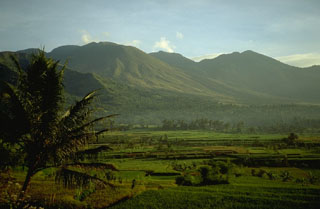 Guntur is composed of older volcanic complexes on the NW and a younger group of cones on the SE. The youngest cone, Guntur (whose name means "thunder"), has been the source of frequent explosive eruptions in the 19th century. This view is from the Volcanological Survey of Indonesia observatory on the south side of the volcano. The peak at the right is Gunung Picung.
Guntur is composed of older volcanic complexes on the NW and a younger group of cones on the SE. The youngest cone, Guntur (whose name means "thunder"), has been the source of frequent explosive eruptions in the 19th century. This view is from the Volcanological Survey of Indonesia observatory on the south side of the volcano. The peak at the right is Gunung Picung.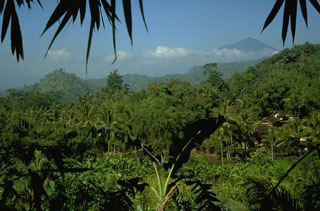 The forested hills in the foreground are part of a massive, hummocky debris-avalanche deposit that originated from a prehistoric flank collapse of Guntur volcano, seen in the distance at the upper right.
The forested hills in the foreground are part of a massive, hummocky debris-avalanche deposit that originated from a prehistoric flank collapse of Guntur volcano, seen in the distance at the upper right.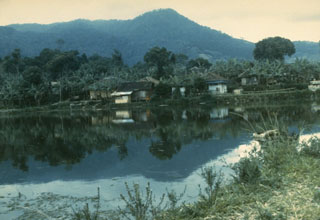 The older NW portion of Guntur volcano rises above a small lake at the Cipanas hot spring resort SE of the volcano. Guntur and neighboring volcanoes surrounding the plain of Garut were some of the oldest tourist destinations in Java.
The older NW portion of Guntur volcano rises above a small lake at the Cipanas hot spring resort SE of the volcano. Guntur and neighboring volcanoes surrounding the plain of Garut were some of the oldest tourist destinations in Java.  Gunung Guntur at the right center is the youngest cone of the volcanic complex. It consists of a younger SW part consisting of cones lying along a NW-SE trend and an older, more eroded complex to the NW. Youthful lava flows can be seen on the lower right-hand flanks of Guntur, whose name means "thunder," a reflection of frequent eruptions in the 19th century.
Gunung Guntur at the right center is the youngest cone of the volcanic complex. It consists of a younger SW part consisting of cones lying along a NW-SE trend and an older, more eroded complex to the NW. Youthful lava flows can be seen on the lower right-hand flanks of Guntur, whose name means "thunder," a reflection of frequent eruptions in the 19th century. 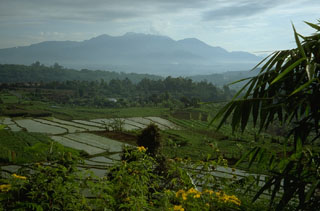 Guntur volcano is viewed here from the S near the base of Papandayan, looking across rice fields in the plain of Garut. The rounded profile of Gunung Guntur, the youngest cone of the volcanic complex, appears on the right horizon.
Guntur volcano is viewed here from the S near the base of Papandayan, looking across rice fields in the plain of Garut. The rounded profile of Gunung Guntur, the youngest cone of the volcanic complex, appears on the right horizon.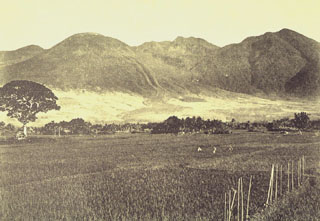 The prominent levees of a historical lava flow (center) are visible on the SE flank of Guntur. The rounded summit at the left is Gunung Guntur, the youngest peak of the volcanic complex. To the right are Gunung Batususun and Gunung Picung, part of the older massif.
The prominent levees of a historical lava flow (center) are visible on the SE flank of Guntur. The rounded summit at the left is Gunung Guntur, the youngest peak of the volcanic complex. To the right are Gunung Batususun and Gunung Picung, part of the older massif.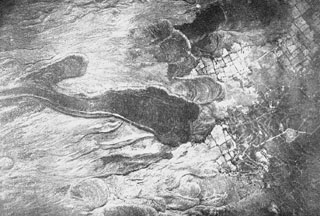 Lava flows, some of historical age, on the SE flank of Guntur volcano, encroaching on cultivated fields. Prominent flow levees are visible on the youngest lava flow that was emplaced over levees of older flows.
Lava flows, some of historical age, on the SE flank of Guntur volcano, encroaching on cultivated fields. Prominent flow levees are visible on the youngest lava flow that was emplaced over levees of older flows.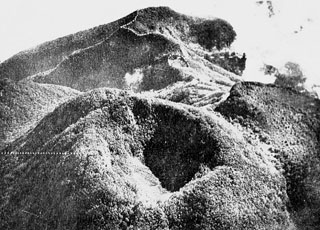 The summit of Guntur volcano is seen here in an aerial view from the SW with the crater of Gunung Masigit in the foreground. The forested 250-350 m wide crater is about 100 m deep. A smaller crater is to the top center below the Agung crater (top). The historically active crater of Guntur is off the photo to the right.
The summit of Guntur volcano is seen here in an aerial view from the SW with the crater of Gunung Masigit in the foreground. The forested 250-350 m wide crater is about 100 m deep. A smaller crater is to the top center below the Agung crater (top). The historically active crater of Guntur is off the photo to the right.The following 2 samples associated with this volcano can be found in the Smithsonian's NMNH Department of Mineral Sciences collections, and may be availble for research (contact the Rock and Ore Collections Manager). Catalog number links will open a window with more information.
| Catalog Number | Sample Description | Lava Source | Collection Date |
|---|---|---|---|
| NMNH 101601 | Unidentified | -- | -- |
| NMNH 116701-1 | Andesite | SE FLANK | -- |
| Copernicus Browser | The Copernicus Browser replaced the Sentinel Hub Playground browser in 2023, to provide access to Earth observation archives from the Copernicus Data Space Ecosystem, the main distribution platform for data from the EU Copernicus missions. |
| MIROVA | Middle InfraRed Observation of Volcanic Activity (MIROVA) is a near real time volcanic hot-spot detection system based on the analysis of MODIS (Moderate Resolution Imaging Spectroradiometer) data. In particular, MIROVA uses the Middle InfraRed Radiation (MIR), measured over target volcanoes, in order to detect, locate and measure the heat radiation sourced from volcanic activity. |
| MODVOLC Thermal Alerts | Using infrared satellite Moderate Resolution Imaging Spectroradiometer (MODIS) data, scientists at the Hawai'i Institute of Geophysics and Planetology, University of Hawai'i, developed an automated system called MODVOLC to map thermal hot-spots in near real time. For each MODIS image, the algorithm automatically scans each 1 km pixel within it to check for high-temperature hot-spots. When one is found the date, time, location, and intensity are recorded. MODIS looks at every square km of the Earth every 48 hours, once during the day and once during the night, and the presence of two MODIS sensors in space allows at least four hot-spot observations every two days. Each day updated global maps are compiled to display the locations of all hot spots detected in the previous 24 hours. There is a drop-down list with volcano names which allow users to 'zoom-in' and examine the distribution of hot-spots at a variety of spatial scales. |
|
WOVOdat
Single Volcano View Temporal Evolution of Unrest Side by Side Volcanoes |
WOVOdat is a database of volcanic unrest; instrumentally and visually recorded changes in seismicity, ground deformation, gas emission, and other parameters from their normal baselines. It is sponsored by the World Organization of Volcano Observatories (WOVO) and presently hosted at the Earth Observatory of Singapore.
GVMID Data on Volcano Monitoring Infrastructure The Global Volcano Monitoring Infrastructure Database GVMID, is aimed at documenting and improving capabilities of volcano monitoring from the ground and space. GVMID should provide a snapshot and baseline view of the techniques and instrumentation that are in place at various volcanoes, which can be use by volcano observatories as reference to setup new monitoring system or improving networks at a specific volcano. These data will allow identification of what monitoring gaps exist, which can be then targeted by remote sensing infrastructure and future instrument deployments. |
| Volcanic Hazard Maps | The IAVCEI Commission on Volcanic Hazards and Risk has a Volcanic Hazard Maps database designed to serve as a resource for hazard mappers (or other interested parties) to explore how common issues in hazard map development have been addressed at different volcanoes, in different countries, for different hazards, and for different intended audiences. In addition to the comprehensive, searchable Volcanic Hazard Maps Database, this website contains information about diversity of volcanic hazard maps, illustrated using examples from the database. This site is for educational purposes related to volcanic hazard maps. Hazard maps found on this website should not be used for emergency purposes. For the most recent, official hazard map for a particular volcano, please seek out the proper institutional authorities on the matter. |
| IRIS seismic stations/networks | Incorporated Research Institutions for Seismology (IRIS) Data Services map showing the location of seismic stations from all available networks (permanent or temporary) within a radius of 0.18° (about 20 km at mid-latitudes) from the given location of Guntur. Users can customize a variety of filters and options in the left panel. Note that if there are no stations are known the map will default to show the entire world with a "No data matched request" error notice. |
| UNAVCO GPS/GNSS stations | Geodetic Data Services map from UNAVCO showing the location of GPS/GNSS stations from all available networks (permanent or temporary) within a radius of 20 km from the given location of Guntur. Users can customize the data search based on station or network names, location, and time window. Requires Adobe Flash Player. |
| DECADE Data | The DECADE portal, still in the developmental stage, serves as an example of the proposed interoperability between The Smithsonian Institution's Global Volcanism Program, the Mapping Gas Emissions (MaGa) Database, and the EarthChem Geochemical Portal. The Deep Earth Carbon Degassing (DECADE) initiative seeks to use new and established technologies to determine accurate global fluxes of volcanic CO2 to the atmosphere, but installing CO2 monitoring networks on 20 of the world's 150 most actively degassing volcanoes. The group uses related laboratory-based studies (direct gas sampling and analysis, melt inclusions) to provide new data for direct degassing of deep earth carbon to the atmosphere. |
| Large Eruptions of Guntur | Information about large Quaternary eruptions (VEI >= 4) is cataloged in the Large Magnitude Explosive Volcanic Eruptions (LaMEVE) database of the Volcano Global Risk Identification and Analysis Project (VOGRIPA). |
| EarthChem | EarthChem develops and maintains databases, software, and services that support the preservation, discovery, access and analysis of geochemical data, and facilitate their integration with the broad array of other available earth science parameters. EarthChem is operated by a joint team of disciplinary scientists, data scientists, data managers and information technology developers who are part of the NSF-funded data facility Integrated Earth Data Applications (IEDA). IEDA is a collaborative effort of EarthChem and the Marine Geoscience Data System (MGDS). |